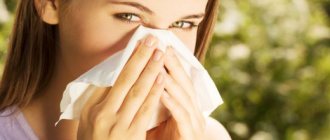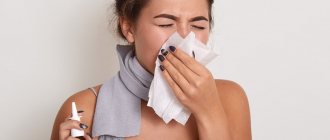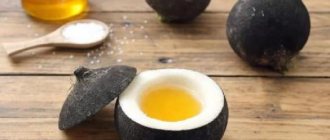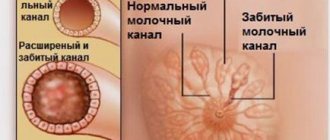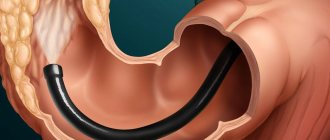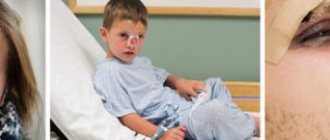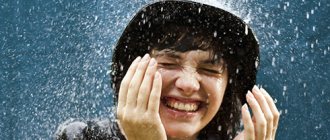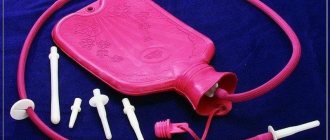Today in pharmacies you can find many solutions for rinsing the nasal cavity. These remedies help cope with a runny nose and make the patient feel better by reducing the amount of discharge. Also, preparations for rinsing the nose fight swelling and provide the mucous membrane with intense hydration.
Today in pharmacies you can find many solutions for rinsing the nasal cavity. These remedies help cope with a runny nose and make the patient feel better by reducing the amount of discharge. Also, preparations for rinsing the nose fight swelling and provide the mucous membrane with intense hydration.
What are these funds?
The basis of the vast majority of nasal rinsing solutions is sea water. This component is able to effectively remove mucus from the nose along with the viruses and bacteria found in it, and also cope with swelling due to the salt content in the composition.
Sea salt naturally fights inflammation, soothes irritated mucous membranes, and helps eliminate wounds and microcracks that appear due to frequent nose blowing. In addition, sea water contains useful microelements, such as iodine, which has a bactericidal effect.
Often, rinsing solutions are physiological, that is, the salt concentration in them is 0.9%, which corresponds to the internal environment of the body. Therefore, preparations based on saline solution are absolutely safe and approved for use even for newborns.
What to wash with?
The best option is to buy a special rinsing solution at the pharmacy. But you can prepare the solution yourself. To do this, you will need a sterile saline solution (you can buy it at a pharmacy, or in extreme cases, replace it with boiled water, preferably pre-filtered), salt and iodine. The optimal concentration is 1 teaspoon of salt and 1 drop of iodine per glass of water. There is no need to prepare a more saturated solution. This will lead to dryness of the nasal mucosa, burning and decreased local immunity.
IMPORTANT! Regular finely ground table salt and cosmetic bath salts, especially those with additives and flavorings, are not suitable for rinsing. You need to purchase coarse sea salt (available at most grocery stores).
How can you rinse your nose with a runny nose? More details
"Dolphin"
This remedy for the common cold includes portioned powders for preparing a solution and a special container for rinsing the nasal cavity.
The composition of the classic “Dolphin” includes a mineral complex and plant components: licorice and rose hip extracts. When the powder is diluted with water, the patient receives an isotonic solution, which, due to additional components, has anti-inflammatory, antiseptic and immunomodulatory effects.
For people prone to allergic reactions, a special “Dolphin for allergies” was created, which contains only a complex of minerals, without the addition of herbal ingredients.
Do essential oils help with rhinitis?
Yes, inhalation with essential oils is considered one of the effective methods of preventing runny nose due to the pronounced antiseptic, antiviral, bactericidal and anti-inflammatory properties of these compounds8. Most essential oils contain terpenes, saponins, or similar substances. They have the ability to contract blood vessels, cleanse the mucous membranes, respiratory tract, and also dilute secretions.
It is also important that during inhalation, the evaporation of oils has a direct effect on the nasopharyngeal mucosa. This also makes it possible to soften tissues, reduce their irritation and maceration caused by prolonged use of nasal drugs9.
But even though they are all-natural substances, essential oil therapy is not for everyone. Contraindications to inhalations with their use are individual intolerance to odors, allergies to flowering plants, asthma, heart pathologies, and in some cases, pregnancy.
"Aquamaris"
This line of nasal rinsing products is represented by several drugs, each of which has specific indications for use:
- “Aquamaris Strong” is produced on the basis of purified sea water and helps fight a severe runny nose, including in the presence of inflammatory processes in the sinuses: sinusitis, rhinosinusitis.
- "Aquamaris Sense". A drug whose active ingredients are sea water and ectoine, which protects the cell wall from damage. The product is intended for the treatment of allergic rhinitis.
- “Aquamaris Plus” - in addition to sea water, contains a healing component - dexpanthenol, which helps irritated mucous membranes recover in a short time.
Aquamaris drugs are relatively inexpensive, which is why they are popular among patients.
How to do inhalations for adults and children?
There are several ways to perform inhalations at home. The most famous of them is to breathe over a saucepan or kettle. However, at the same time, this is also the most unsafe method: if you are careless, you can get a burn to the mucous membrane or be doused with boiling water.
A non-traumatic alternative to this “old-fashioned” approach is the use of steam inhalers (for example, the Machold inhaler). A more budget-friendly option may be to use an aroma lamp, however, this eliminates the “targeted” delivery of fumes to the problem area, and the intensity of the impact will be much less.
It is definitely worth mentioning passive inhalations, when essential oils are soaked, for example, in napkins, which are then laid out around the house or carried with you. One of the modern options for supporters of this approach is the use of special patches that are glued to clothing.
In pediatric practice, passive inhalations are considered the most suitable for the treatment of runny nose in children10, since they eliminate the possibility of a negative reaction to physical intervention and do not lead to irritation of the mucous membrane (unlike instillation).
"Aqualor"
The Aqualor solution is available in the form of a spray with a continuous spray system, which helps to quickly and effectively rinse the nasal cavity. The drug is based on sea water. The range of products includes:
- “Aqualor Soft”, which gently cleanses and moisturizes the mucous membrane of a runny nose.
- "Aqualor Norm", which is intended for deep cleansing of the nasal cavity during rhinitis.
- “Aqualor Forte” and “Extra Forte” - ease breathing during congestion without developing addiction.
- "Aqualor Active Soft", created specifically for the treatment of prolonged runny nose.
- "Aqualor Active Forte", capable of coping with a severe runny nose.
For children, which can be used to rinse the nose of infants.
In what cases do doctors recommend rinsing your nose?
- Rhinitis. A runny nose can be the result of an infection or a reaction to an allergen. Rinsing the nose in such cases eliminates particles that irritate the mucous membrane and removes accumulated mucus, significantly alleviating the patient’s condition.
- Sinusitis. This is an inflammation of the sinuses, in which it is quite difficult to deliver medicine to the inflamed area. A common form of this disease is sinusitis. In accordance with your doctor's recommendations, you can carry out rinsing procedures at home, but for sinusitis it is better to perform them in the hospital.
- After surgery. Rinsing is necessary for careful restoration of the mucous membrane.
"Marimer"
The drug is an isotonic solution prepared from purified sea water. "Marimer" contains microelements that have a beneficial effect on the functioning of the ciliated epithelium of the nasal cavity. As a result, the resistance of the mucous membrane to infectious agents – viruses and bacteria – increases.
The drug is approved for use by pregnant women and children over 1 year of age. Can be used to relieve allergic rhinitis.
To rinse your nose, it is not necessary to buy pharmacy aerosols - can the solution be prepared at home?
This is true if you do not take into account issues of comfort and safety. Irrigation can be done with salted water or ordinary saline solution. But the use of aerosols is simply more convenient: the stream enters the nose under pressure and irrigates a large area of the mucous membrane. The second nuance is that if you prepare the solution yourself, you can make a mistake with the concentration and get a burn to the nasal cavity, but in pharmaceutical preparations everything is thoroughly verified. They are also completely sterile.
All saline solutions are the same, so there is no need to consult a pharmacist when purchasing them.
As we have already said, saline solutions from the pharmacy are safe when used correctly, but the buyer may still need the help of a front desk employee. There is a difference between these drugs, and it lies in the concentration of salt. Isotonic (physiological) solutions are identical in this regard to natural body fluids.
But in hypertonic solutions the salt content is increased. Both are used to irrigate the nose. But isotonics are better suited for hygienic purposes and preparing the mucous membrane for the use of other drugs. But hypertensive drugs were created precisely to relieve the symptoms of rhinitis. In pharmacies you can buy sprays and powders for diluting both types of drugs, so it would be useful to find out exactly why the buyer needs the drug.
How to properly rinse your nose?
Rinsing the nasal cavity is a simple procedure, but to perform it you need to know a few rules. First, one nostril is irrigated with the required amount of solution. The head must be tilted in the same direction. After the product helps make the mucus more liquid, you should blow your nose without making too much effort. Then do the same manipulations on the other side.
If the procedure is performed on an infant, the first nostril to be irrigated is the one from below in a position on its side.
To rinse the nose with a stream, for example, using a device from Dolphin, a person is required to have a certain skill, which, however, is quickly acquired through practice. Holding one nostril closed, lean over the sink and pour the solution into the other nostril, squeezing the bottle. Then wait until the liquid comes out of the second nostril. Repeat this sequence of actions on the opposite side.
So, at least one of the preparations for rinsing the nasal cavity should be kept in your home medicine cabinet. These drugs work effectively both for the prevention of acute respiratory viral infections and colds, and as a component of the treatment of these diseases. A seawater-based spray will help you survive seasonal allergies. Finally, the solutions are sterile and safe and can be used for daily hygiene.
They say that rinsing the nose with saline solutions can provoke otitis media?
There is indeed a risk of the solution getting into the middle ear, but if everything is done correctly, it is minimal. It is strictly forbidden to rinse the nose (without using a special device - an aspirator) only for children under 5 years of age. The reason is the immaturity of the auditory tube. In adults, this organ is usually closed and opens only when swallowing, speaking, or yawning. But in children, the auditory tube is open all the time, so fluid and mucus washed away easily get there.
Theoretically, this could happen to an adult, but the chances of this are not so great. In addition, water entering the middle ear does not always lead to otitis media. Everything can be limited to discomfort due to the pressure drop caused by foreign fluid. It’s another matter if pathogenic microflora penetrates into the Eustachian tube - there is a really high risk of developing inflammation.
To prevent this from happening, just follow a few recommendations:
- do not press too hard on the cylinder so that the pressure of the liquid is not too powerful;
- do not rinse your nose when it is very blocked - first you need to instill a vasoconstrictor and clear the cavity of excess secretion;
- do not go outside immediately after washing;
- do not use saline solutions if you have diagnosed otitis media or damage to the eardrum;
- while rinsing your nose, lean forward at a right angle;
- It is correct to blow your nose after the procedure: only with one nostril and with your mouth slightly open.
Following these tips makes nasal irrigation a safe enough procedure to perform at home.
Ear toilet: who needs it, how it’s done
Professional treatment of the auricle and ear canal is indicated for otitis media, as well as for the formation of cerumen plugs or to remove a foreign object. Before visiting an otolaryngologist, you may also need to clean your ear so that the otolaryngologist can examine the organ and assess the condition of the eardrum.
If necessary, the entrance to the ear is treated with an antiseptic to remove pus, skin scales, and dirt. Next comes the basic cleansing. There are two ways:
- Dry. This is done using a special probe. Sterile cotton wool is wrapped around the tip of the instrument. The healthcare worker carefully inserts the instrument into the passage and gradually cleans it with rotating, blotting movements. Contaminated cotton wool is replaced several times with new one. The manipulations are repeated until the cotton tip stops getting dirty. The ENT monitors the process using an otoscope. The probe is immersed into the ear no more than 2–2.5 centimeters.
- Wet. It is used to treat the ear during an inflammatory process or to remove wax plugs. Use an antiseptic or saline solution. To create the necessary pressure, take a large syringe. There are also devices - irrigators with special attachments. Before getting rid of the sulfur plug, it is softened with special drops or hydrogen peroxide.
After cleaning the ear canal, the outer ear is treated with an alcohol solution, an antiseptic, or boric acid of your choice.
Features of the procedure
Irrigation houses usually use:
- syringe 70 - 150 ml;
- a large syringe (without a needle, of course);
- irrigators, which can be purchased at the pharmacy.
First, you need to clear your nasal passages of mucus as much as possible. In case of severe swelling, you should use a vasoconstrictor within 10-15 minutes. It is most convenient to carry out irrigation in the bathroom, above the sink. The head is tilted to the side so that one nostril is above the other. The liquid is introduced into the upper nasal passage and exits from the lower one. While passing the solution, you must breathe frequently. After this, the head is tilted in the opposite direction and the same actions are performed.
It is better to start the procedure with the nostril that is less blocked. Do not apply the solution under strong pressure or place the tip of the device deep into the nose. At first, if you don’t have the skill, the liquid will partially flow into your throat and you can spit it out. Isolation of the nasopharynx is facilitated by the repetition of “ku-ku” sounds or prolonged vowels during irrigation.
It takes about 200 ml of solution to rinse both cavities. After the procedure, you need to sit for about 10 minutes, leaning slightly forward, so that the mucus drains from the sinuses. Then gently blow your nose. The procedure is repeated several times a day.
In some cases, the doctor may recommend flushing the sinuses in a clinical setting, where more effective irrigation methods are used:
- The “Cuckoo” procedure is based on creating a pressure difference in the cavities by supplying a solution into one nostril and pumping it out with an aspirator from the other.
- The Yamic catheter is a system of tubes and balloons operating on the vacuum principle. The therapeutic procedure is performed by an otolaryngologist under local anesthesia.
Can I use a nebulizer to inhale essential oils?
Not worth it. The fact is that the correct use of essential oils involves their evaporation, and nebulizers, like compressor inhalers, work on a different principle. These devices turn oil into a cold, fine cloud that penetrates deep into a person's lungs. In the case of ether compounds, this is extremely undesirable, as it can lead to the development of oil pneumonia, a severe type of pneumonia.11
Sources
- Chow AW, Benninger MS, Brook I, Brozek JL, Goldstein EJ, Hicks LA et al. IDSA clinical practice guideline for acute bacterial rhinosinusitis in children and adults. Clin Infect Dis. 2012; 54(8): 72-112. DOI: https://doi.org/10.1093/cid/cis370
- WHO. Virology of human influenza // https://www.euro.who.int/ru/health-topics/communicable-diseases/influenza/data-and-statistics/virology-of-human-influenza
- Zaplatnikov A.L. Safe use of nasal vasoconstrictor drugs in children // https://www.rmj.ru/articles/pediatriya/Bezopasnoe_primenenie_nazalynyh_sosudosughivayuschih_preparatov_u_detey/
- Malakhov A.B., Shatalina S.I., Dronov I.A., Malakhova-Kapanadze M.A., Denisova A.R. Topical decongestants in the complex therapy of acute respiratory infections in children (literature review) // Medical Council. 2015. No. 14. P. 26-29 // https://www.med-sovet.pro/jour/article/view/354?locale=ru_RU
- Pshenichnaya E.V., Dudchak A.P., Usenko N.A. Decongestants and their side effects in the treatment of acute rhinitis in children (clinical example) // https://mednauki.ru/index.php/MD/article/view/223/482
- Federal clinical recommendations for the provision of medical care to children with acute respiratory viral infection (acute nasopharyngitis) M.: Union of Pediatricians of Russia; 2015. 12 p. // https://www.pediatr-russia.ru/sites/default/files/file/kr_onaz.pdf
- Karpova E.P., Tulupov D.A. Nasal vasoconstrictor drugs in pediatric practice. Effective pharmacotherapy. 2012. No. 9. P. 18-22 // https://umedp.ru/articles/nazalnye_sosudosuzhivayushchie_preparaty_v_pediatricheskoy_praktike.html
- Nagornaya N.V. Aromatherapy in pediatrics. Prague: Cosmetio Karl Hadek International 1998.
- Bogomilsky M. R., Chistyakova V. R. Pediatric otorhinolaryngology. M.: GEOTAR-Media, 2006. // https://www.rosmedlib.ru/book/ISBN9785970422595.html
- Reducing the drug burden on the children's body: experience in using essential oils for the prevention and treatment of acute respiratory infections. RMJ No. 9 from 09/05/2018 pp. 13-17 https://www.rmj.ru/articles/pediatriya/Umenyshenie_lekarstvennoy_nagruzki_na_detskiy_organizm_opyt_ispolyzovaniya_efirnyh_masel_dlya_profilaktiki_i_lecheniya_ostryh_respiratornyh_infekciy/#ix zz6cuLCTMzB
- Princely N.P. Features of the use of nebulizers in the treatment of chronic lung diseases. RMJ No. 18 dated September 26, 2017 // https://www.rmj.ru/articles/bolezni_dykhatelnykh_putey/Osobennosti_ispolyzovaniya_nebulayzerov_v_terapii_hronicheskih_zabolevaniy_legkih/
When is consultation with an otolaryngologist necessary?
If you suspect sinusitis, a persistent runny nose, ear inflammation, or partial hearing loss, you need to consult a specialist. Deep cleansing of the nose, sinuses, and ear canal is safe to do only in a clinic. An ENT specialist will assess the condition, prescribe medicine, and prescribe physiotherapy.
Cleansing the ENT organs is an auxiliary action in the treatment of inflammatory processes. They are combined with drug therapy and physiotherapy. The frequency and duration of procedures will be determined by the otolaryngologist.
Medical appointments are conducted by specialists with about 10 years of experience. Professional cleansing of ENT organs is available for patients of any age. It is carried out quickly, painlessly, manually or using modern equipment.
